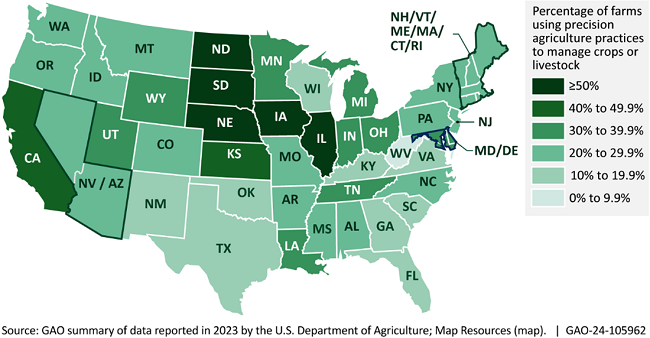Precision Agriculture: Benefits and Challenges for Technology Adoption and Use
Fast Facts
Precision agriculture uses technologies such as GPS or automation to make farms more efficient. For example, farmers can use auto-steering equipment to precisely plant a field, and activity monitors can help dairy farmers collect data about their cows' health.
In this Technology Assessment, we review the benefits and challenges of precision agriculture technologies. They can make farms more profitable and have environmental benefits—like reducing fertilizer runoff in waterways. But they can also be complex and have high up-front costs, making it hard for some farmers to access them. We examine policy options to help address these challenges.
Artist’s concept of an autonomous tractor working in a corn field

Highlights
What GAO Found
Precision agriculture technologies can improve resource management through the precise application of inputs, such as water, fertilizer, and feed, leading to more efficient agricultural production. Precision agriculture can be implemented through a suite of technologies that can be used in isolation or in conjunction with other technologies. Examples of emerging precision agriculture technologies are in the table below.
Examples of emerging precision agriculture technologies
| Technology | Description |
|---|---|
| Remote sensing platforms | Drones and ground robots can provide new ways to provide measurements on crop conditions. |
| In-ground sensors | Provide farmers near-real-time information on soil and plant properties such as temperature, moisture, and nutrients. |
| Targeted spray systems | Use machine learning to precisely spray in a specific spot. |
| Automated mechanical weeders | Use machine learning to start and stop weeding blades to avoid damaging the growing crops. |
Source: GAO summary of literature, interviews, and agency documentation. | GAO-24-105962
While precision agriculture technologies, such as variable rate fertilizer applications and yield monitoring, have been available since the 1990s, only 27 percent of U.S. farms or ranches used precision agriculture practices to manage crops or livestock, based on 2023 U.S. Department of Agriculture (USDA) reporting.
Use of precision agriculture practices by U.S. farms, June 2022–June 2023

Federal agencies support precision agriculture adoption, research and development, education, and training. USDA supports precision agriculture technology adoption with financial assistance and loan programs, such as through payments for implementing practices that provide a conservation benefit. USDA and the National Science Foundation (NSF) have provided almost $200 million for precision agriculture research and development funding in fiscal years 2017—2021. This funding includes partnerships between the two agencies to support artificial intelligence (AI) research institutes.
Benefits to using precision agriculture technologies include:
- Increased profits. Farmers can increase yields and thus profits with the same amount of inputs or achieve an equivalent yield with fewer inputs.
- Reduced application of crop inputs. Technologies can reduce the application of crop inputs such as fertilizer, herbicide, fuel, and water. They can also address water scarcity by promoting the efficient use of water in agriculture.
- Environmental benefits. Technologies can prevent excessive use of chemicals and nutrients in a field, potentially reducing runoff into soil and waterways.
Challenges limiting the broader adoption and use of precision agriculture include:
- High up-front acquisition costs. Acquisition costs for the latest technologies can be prohibitive for farmers with limited resources or access to capital.
- Farm data sharing and ownership issues. Concerns regarding farm data sharing and ownership can pose obstacles to the widespread use of AI in agriculture.
- Lack of standards. An absence of uniform standards can hamper interoperability between different precision agriculture technologies.
GAO examined three policy goals and associated options that could help address adoption challenges or enhance the benefits of precision agriculture technologies. These policy options identify possible actions by policymakers, which include Congress, federal agencies, state and local governments, academic and research institutions, and industry. In addition, for each policy goal, policymakers may choose no additional policy interventions, maintaining the status quo by continuing existing activities.
Policy Goals and Options That Could Address Challenges or Help Enhance Benefits of Adoption and Use of Precision Agriculture Technologies
| Policy goals and options | Implementation approaches | Opportunities and considerations |
|---|---|---|
| Encourage greater adoption and use (report p. 43) | ||
| Provide additional incentives or other financial support |
|
|
| Better understand and quantify benefits and costs |
|
|
| Promotion and outreach to farmers |
|
|
| Encourage further innovation (report p. 48) | ||
| Conduct research and development to improve on-farm data gathering and analysis |
|
|
| Promote the development and use of standards |
|
|
| Manage greater amounts of data (report p. 52) | ||
| Enhance data analysis |
|
|
| Encourage data sharing |
|
|
Source: GAO. | GAO-24-105962
Why GAO Did This Study
Precision agriculture involves collecting, analyzing, and taking actions based on data. It can help the agricultural sector meet increasing demand for food products, while also helping farmers improve efficiencies such as through reduced input costs.
The Advancing IoT for Precision Agriculture Act of 2021, contained in what is commonly referred to as the CHIPS and Science Act of 2022, included provisions for GAO to conduct a technology assessment and review federal programs.
This report examines (1) emerging precision agriculture technologies and precision agriculture technology adoption; (2) federal programs providing support for precision agriculture; (3) benefits and challenges of adopting and using precision agriculture technologies; and (4) policy options that could address challenges or help enhance benefits of adopting and using precision agriculture technologies.
To conduct this technology assessment and review, GAO reviewed scientific literature and other key reports; interviewed officials and representatives from government, industry, academia, and associations; conducted two site visits to observe technology operations and obtain stakeholder perspectives; and convened a 3-day virtual expert meeting in collaboration with the National Academies of Sciences, Engineering, and Medicine. GAO is identifying policy options in this report.
For more information, contact Brian Bothwell at (202) 512-6888 or BothwellB@gao.gov, or Steve D. Morris at (202) 512-3841, morriss@gao.gov.
